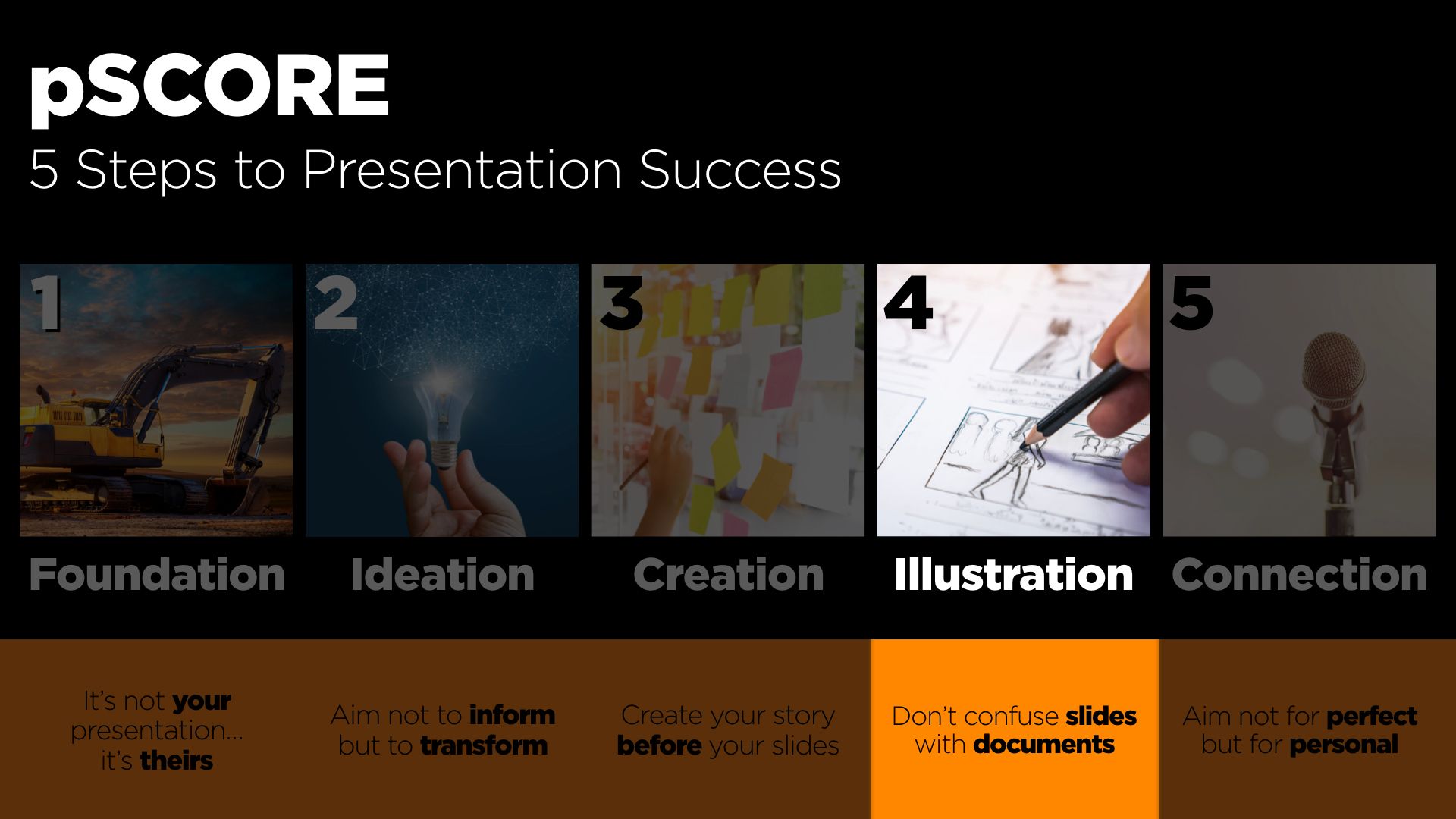Business Presentation Revolution covers the five stages of the Presentation SCORE Method, or pSCORE, giving you a simple, proven process to follow to prepare and deliver successful presentations every time.
In this extract from Business Presentation Revolution, author Phil Waknell outlines the fourth stage: Illustration.
Humans can only process one linguistic input at a time: this means that if you show your audience a slide while you’re speaking, they have to choose either to read or to listen. So, if your slide features a lot of text and detail, it might make a useful reference document but a terrible visual aid. If you follow my advice and keep your slides simple, with only a few words, they’ll be good visual aids but worthless as handouts.
Most people try to do something in the middle and end up with too little text for a useful reference document but too much for a visual aid – 50% slide, 50% document, 0% effective.
In the Illustration stage, you will first work out whether your audience will benefit from handouts, then determine whether some slides might help them during your presentation, and if so, prepare suitable visual aids that won’t stop them from listening.

What you say is important, but the quality of your visual aids can have a huge positive or negative impact. Telling a great story with ugly slides is like giving somebody expensive jewelry in a supermarket plastic bag.
I think of slides as “visual aids” for a presentation, and just that semantic change helps clients break out of the typical perception of a slide and focus on what kind of visuals will aid their audience’s understanding and recollection of their key messages.
Your slides should SCORE:
- Simple: Each time you click, your audience should understand all the new content in under five seconds. If they take more than five seconds to “get it”, they will miss what you are saying.
- Clear: Everything is easy to read and understand on a smartphone screen, in terms of size and contrast.
- Original: Your slides look new and stand out compared to competitors’ and other speakers’ slides.
- Related: What you show is related to what you are saying at that time.
- Enjoyable: Your slides are well-designed and attractive, making your audience enjoy discovering each new slide.
You might also need to deliver some handouts. No matter how well your slides SCORE, the audience will soon forget what you say and what you show, so it may be wise to give them something to read before your presentation and to leave something behind – but not an ugly slideument that is neither a good slide nor a good document.
Here is an overview of the pSCORE method for illustrating your storyline:
- Prepare any necessary handouts for your audience to read before, during or after your presentation.
- Split your storyline into paragraphs or points, and, for each part, work out whether your audience would benefit from a visual aid to help them understand and/or remember it.
- Where a visual aid might help, identify the most appropriate kind: a physical action, perhaps with an object; a video; a whiteboard or flipchart; or a slide.
- Sketch any slides you need on paper or sticky notes.
- Create a storyboard containing your sketches and clear instructions for your designer.
- Complete the pSCORE Slide Design Checklist* to ensure you are telling your designer everything they need to know. (If you are designing your own slides, this can still be helpful.)
- If the first version of your slides is perfect, great! If not, provide clear slide-by-slide instructions showing your designer what to change so the second version is exactly what you need.
- When you receive the second version, double-check that all transitions, animations and fonts look exactly as they should, and that you are comfortable delivering your presentation with these slides.
By the end of the Illustration stage, you should have your story and slides, perhaps with some useful handouts, and you can move on to the Connection stage, where you will prepare to deliver your presentation to your audience. Like the Foundation stage at the start of the process, the Connection stage is often neglected or rushed, yet it can make the difference between failure and success.
To learn more about this and the other stages of the Presentation SCORE Method, or pSCORE, get your paperback copy of Business Presentation Revolution from Amazon or any good bookseller. Also available as an e-book from Amazon.
* This checklist and many other downloadable supporting materials are available on a special web site: the link is in the book.